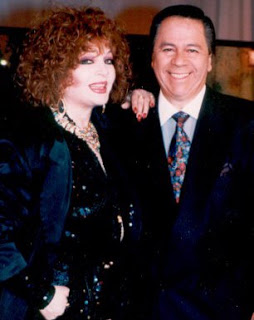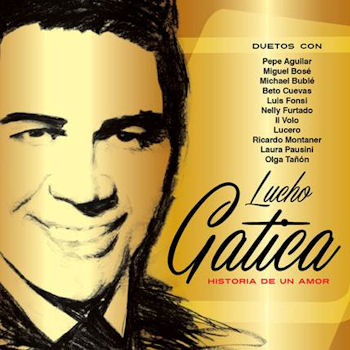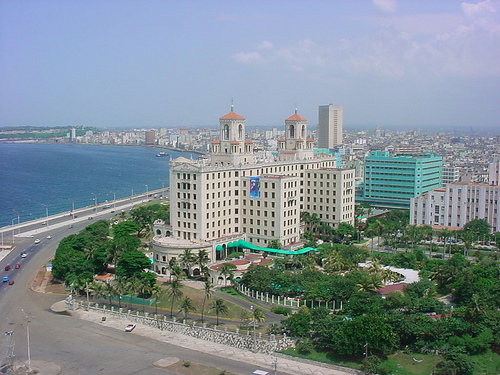LUCHO GATICA IN CUBA. HIS TRIUMPHS.
Recently a Chilean friend told me about his recent conversation with Lucho Gatica. The famous bolerista, with almost 90 years old and who lives in Miami, with joy and nostalgia we evoked his Cuban days. It could not be otherwise because Lucho was an idol in the Cuba of the 1950s Suffice to say that in the 1958 hit parade -given released on December 21 of that year three pieces performed by him appear between the 14 selected. Picolissima are serenade, Renato Carossone; Beyond you, Alvaro Carrillo; and back to me, Carmen Lombardo.
Lucho first came to Havana in 1954, hired by Radio Progreso, the wave of joy. It was all but unknown. The success here then poured passport in Mexico City, where he consolidated his fame.
Gaspar Pumarejo brings him in 1957 for presentation at the School of Television, which airs in the evenings, by Channel 2-Tele World. Is the highlight of Lucho Gatica on the island.
..the Confused the dates of the visits and perhaps the players and the order in which the songs were recorded. Lucho came several times and sometimes spent long periods here. It seems it was Olga Guillot who led the first visit of Lucho Gatica to Havana. The woman who inspired his very famous René Touzet bolero night last night, heard him sing in Chile and marveled.
Lucho, who took his first steps in the bolero, then sang tangos, cuecas and other folk airs of their land. She sang it for her accompanying himself on guitar, and she, a cappella, played for him boleros Jose Antonio Mendez and Cesar Portillo de la Luz. The Guillot asked his representative Eugenio (Tito) Garrote that Lucho should manage a trip to Cuba that was, at the time, the obligation of an artist to jump to fame site. “He will be thrilled with the end Filin and recording boleros as Delirium, The glory is you, you in the distance …” he recalled the Guillot years later. And he pleased, he recalled, “Olga said she and I were the king of the bolero.”
It comes in the Montmartre cabaret the lavish 23 and P, Vedado, as part of a cast that also included Edith Piaf. Then a long time ago in the Parisien, National Hotel, where the piano accompanies Frank Dominguez, who recorded his You got used to me. It also records, backed Aida Quartet, I can not be happy, Adolfo Guzman and by our cowardice, Jose Antonio Mendez. For these two numbers is the piano Frank Emilio, who years later will evoke as “a tremendous musician, wonderful.”
He took the acetate pieces of quite a few Cuban composers such as Tania Castellanos (in us), Jose Antonio Mendez (La gloria eres tú girlfriend of mine), Portillo de la Luz (Delirium), René Touzet (The night last night), Pedro Junco ( us), Osvaldo Albuquerque (Sad conviction) … From Urban Gómez Montiel recorded Sing sentimental, that comes thanks to Snowball. They sing in Cuba Portillo Scull, Gina Leon and Elena Burke. Lucho makes it a success, although the version of the Cuban Roberto Ledesma was the most widespread in America. Total also interpreted. Ricardo Garcia Perdomo author keeps unpublished for more than ten years as the “loose” is the last straw. In December 1959, the same year that hits the market, accumulated the unusual figure of 40 versions, including Bertha Dupuy, Olga Guillot, Fernando Alvarez … Nico Membiela sold 15,000 copies of his recording of Total, and another Cuban , Celio Gonzalez in Mexico, 53,000 copies in just three months. The records also Lucho Gatica, who after years acknowledge that you in the distance, Portillo de la Luz, was his first major recording success.
His successes were also Clock, The boat, a love story, The gate, Vanity, Wait for me in heaven, Sincerity, Notorious … Agustin Lara played only once, Holy, Night of Veracruz, Maria Bonita. Armando Manzanero, who was her accompanist, I’ll turn off the light. It is impossible to avoid mentioning the Scriptwriter versions of Besame Mucho, Mexican Consuelo Velázquez, and I do not platiques more, the also Mexican Vicente Garrido. Lucho listened to snowball and fell in love with the piece. He sang and made his forever. Say, “That’s the song that identifies me, it’s mine track. Everyone who sees me on the street, sing to me, I do not platiques more … “.
A Lucho Gatica was presented in Cuba as “the new voice of bolero.” The truth is that Havana, with its great cabarets, television stations, record companies and advertising companies, its lights and endless nights, changed the rhythm to the life of the artist. Lucho not say specialists took bolero in the traditional way, or the way Filin. Theirs was pure romance, a constant invitation to intimacy. Instead of singing, provocatively she is stroking letters and touched his lips to the microphone. “I sang in a sensual way” he would say later. Accurate review: “Was no one not dream and fall in love with his deep, melodious voice.”
Some speak today of “luchomanía” to describe the feelings of sympathy and admiration of the island. That honeymoon, however, he lasted so they last honeymoons. In 1959 came the divorce: Lucho did not understand the justice of the Revolution, made statements against, very hard, and many who hitherto followed him and admired him aside began.
He has always said he deeply loves Cuba. Either way his fame jumped from Havana to Mexico, Venezuela, Argentina, Peru. In Brazil, their successes were apotheosis. He went to Spain and Portugal, and more distant places like the Philippines, Japan, Middle East. In 1966 it was estimated that he had sold some 22 million records, although since 1961 wear on the vocal cords that would aggravate over the years, forcing him to reduce the frequency of recordings and intensity of live entertainment.
HIS LIFE. HIS TRIUMPHS. TODAY.
Luis Enrique Gatica- Lucho Gatica Silva was born in Rancagua on 11 August 1928. It was one of seven children born to Augustine, small farmer and merchant, and Juana, music lover. Father’s death in 1933, made the family knew all kinds of hardships. He attended schools of the Marist brothers and enrolled in a technical school to become a dental technician, which he concluded, but never practiced. And he leaned toward music and a disc with Chilean folk airs recorded a duet with his brother Arthur, opened doors in local stations.
Since then he recorded 20 record or albums, including one that bears the title 50 immortal songs (2002). In 2013 he presented his album Historia de un amor, where a duet with world music figures such as Laura Pausini and Nelly Furtado sing new versions of old boleros. He participated in 15 films, mostly filmed before 1960, in Mexico, where he also did a lot of television. Peruvian writer Mario Vargas Llosa and Alfredo Bryce Echenique evoked in several of his books Lucho figure, his visits to Lima and significance that they had their songs. He married three times and has seven children.
In 2000, Rancagua, his native region, honored. Two years later they paid him honors at the XLIII Viña del Mar International Song Festival, but his voice already in decline disappointed the public. Soon after, the Chilean government granted him the Gabriela Mistral Order of Merit for his contribution to the musical history of his country. On November 7, 2007 he received the Latin Grammy for Excellence, and January 25, 2008 was immortalized in the star number 2354 of Hollywood Walk of Fame, the second Chilean, after Don Francisco, to receive such recognition.
Most recently he received the Pablo Neruda Order of Merit, the highest distinction of the Council of Culture and Arts Chilean figures with artistic and cultural activities of international scope.
Those who could see and hear him singing in the Havana of the 50s still remember him.
CiroBianchiRoss / Juv.RebeldeLecturas / Excerpts/InternetPhotos / YouTube.
The Cuban History, Hollywood.
Arnoldo Varona, Editor.
LUCHO GATICA EN CUBA. SUS TRIUNFOS.
Hace poco un amigo chileno me contaba de su conversación reciente con Lucho Gatica. El afamado bolerista, con casi 90 años de edad y radicado en Miami, evocaba con alegría y nostalgia sus días cubanos. No podía ser de otro modo porque Lucho fue todo un ídolo en la Cuba de la década de 1950. Baste decir que en el hit parade de 1958 —dado a conocer el 21 de diciembre de ese año— tres piezas interpretadas por él aparecen entre las 14 seleccionadas. Son Picolissima serenata, de Renato Carossone; Allá tú, de Álvaro Carrillo; y Regresa a mí, de Carmen Lombardo.
Lucho vino por primera vez a La Habana en 1954, contratado por Radio Progreso, La onda de la alegría. Era poco menos que desconocido. El éxito cosechado aquí entonces le sirvió de pasaporte en la capital mexicana, donde consolidó su fama.
Gaspar Pumarejo lo trae en 1957 para presentarlo en su Escuela de Televisión que sale al aire en las noches, por el Canal 2-Tele Mundo. Es el momento cumbre de Lucho Gatica en la Isla.
..Se confunden las fechas de las visitas y tal vez los protagonistas y el orden en que se grabaron las canciones. Lucho vino varias veces y en ocasiones pasó aquí largas temporadas. Parece que fue Olga Guillot quien propició la primera visita de Lucho Gatica a La Habana. La mujer que inspiró a René Touzet su muy célebre bolero La noche de anoche, lo oyó cantar en Chile y se maravilló.
Lucho, que daba sus primeros pasos en el bolero, cantaba entonces tangos, cuecas y otros aires folclóricos de su tierra. Cantó él para ella acompañándose con su guitarra, y ella, a capela, interpretó para él boleros de José Antonio Méndez y César Portillo de la Luz. La Guillot pidió a su representante Eugenio (Tito) Garrote que gestionase a Lucho un viaje a Cuba que era, en la época, el sitio obligado de un artista para saltar a la fama. «Él se entusiasmaría con el filin y terminaría grabando boleros como Delirio, La gloria eres tú, Contigo en la distancia…», recordaba la Guillot años después. Y él, complacido, rememoraba: «Olga decía que ella y yo éramos los reyes del bolero».
Se presenta en el Montmartre, el fastuoso cabaret de 23 y P, en el Vedado, como parte de un elenco en que también figura Edith Piaf. Hace luego una larga temporada en el Parisién, del Hotel Nacional, donde lo acompaña al piano Frank Domínguez, de quien grabará su Tú me acostumbraste. Graba además, con el respaldo del cuarteto de Aida, No puedo ser feliz, de Adolfo Guzmán, y Por nuestra cobardía, de José Antonio Méndez. Para estos dos números tiene al piano a Frank Emilio, a quien años después evocará como «un músico tremendo, maravilloso».
Llevó al acetato piezas de no pocos compositores cubanos como Tania Castellanos (En nosotros), José Antonio Méndez (La gloria eres tú y Novia mía), Portillo de la Luz (Delirio), René Touzet (La noche de anoche), Pedro Junco (Nosotros), Osvaldo Alburquerque (Triste condena)… De Urbano Gómez Montiel graba Canta lo sentimental, que le llega gracias a Bola de Nieve. La cantan en Cuba Portillo Scull, Gina León y Elena Burke. Lucho la convierte en un éxito, aunque la versión del cubano Roberto Ledesma fue la más difundida en toda América. Interpreta asimismo Total. Su autor Ricardo García Perdomo la mantiene inédita durante más de diez años y cuando la «suelta» es el acabose. En diciembre de 1959, el mismo año en que sale al mercado, acumulaba la insólita cifra de 40 versiones, entre ellas las de Bertha Dupuy, Olga Guillot, Fernando Álvarez… Ñico Membiela vende 15 000 copias de su grabación de Total, y otro cubano, Celio González, en México, 53 000 copias en solo tres meses. La graba también Lucho Gatica, que al cabo de los años reconocería que Contigo en la distancia, de Portillo de la Luz, fue su primer gran éxito discográfico.
Éxitos suyos fueron también Reloj, La barca, Historia de un amor, La puerta, Vanidad, Espérame en el cielo, Sinceridad, Encadenados… De Agustín Lara interpretó Solamente una vez, Santa, Noches de Veracruz, María Bonita. De Armando Manzanero, que fue su pianista acompañante, Voy a apagar la luz. Resulta imposible para el escribidor dejar de mencionar sus versiones de Bésame mucho, de la mexicana Consuelo Velázquez, y No me platiques más, del también mexicano Vicente Garrido. Lucho se la escuchó a Bola de Nieve y se enamoró de la pieza. La cantó y la hizo suya para siempre. Diría: «Esa es la canción que me identifica, es la canción mía. Todo el mundo que me ve en la calle, me canta: No me platiques más…».
A Lucho Gatica se le presentó en Cuba como «la nueva voz del bolero». Lo cierto es que La Habana, con sus grandes cabarets, canales de televisión, empresas disqueras y publicitarias, sus luces y noches sin fin, le cambió el ritmo a la vida del artista. Afirman especialistas que Lucho no asumió el bolero de la manera tradicional, ni a la manera del filin. Lo suyo era puro romanticismo, una invitación constante a intimar. En lugar de cantarlas, acariciaba las letras y rozaba provocativamente sus labios con el micrófono. «Yo cantaba de una manera sensual», diría más tarde. Precisa la crítica: «No hubo quien no soñara y se enamorara con su voz profunda y armoniosa».
Algunos hablan hoy de «luchomanía» para definir los sentimientos de simpatía y admiración que despertó en la Isla. Aquella luna de miel, sin embargo, perduró lo que duran las lunas de miel. En 1959 sobrevino el divorcio: Lucho no entendió la justeza de la Revolución, hizo declaraciones en contra, muy duras, y muchos de los que hasta entonces lo seguían y admiraban empezaron a darle de lado.
Siempre ha dicho que ama profundamente a Cuba. De cualquier manera su fama saltó de La Habana a México, Venezuela, Argentina, Perú. En Brasil, sus éxitos fueron apoteósicos. Pasó a España y Portugal, y a lugares más distantes como Filipinas, Japón, Medio Oriente. En 1966 se calculaba que había vendido unos 22 millones de discos, pese a que desde 1961 un desgaste en las cuerdas vocales que se recrudecería con los años, lo obligaba a reducir la frecuencia de las grabaciones y la intensidad de los espectáculos en vivo.
SU VIDA. SUS TRIUNFOS. HOY.
Luis Enrique Gatica Silva —Lucho Gatica— nació en Rancagua el 11 de agosto de 1928. Era uno de los siete hijos del matrimonio de Agustín, pequeño agricultor y comerciante, y Juana, amante de la música. La muerte del padre, en 1933, hizo que la familia conociera todo tipo de privaciones. Estudió en colegios de los hermanos Maristas y matriculó en una escuela técnica para hacerse mecánico dental, lo que concluyó, pero nunca ejerció. Ya se inclinaba hacia la música y un disco con aires folclóricos chilenos grabado a dúo con su hermano Arturo, le abrió puertas en emisoras locales.
Desde entonces grabó unos 20 albúmenes discográficos, entre ellos el que lleva el título de 50 canciones inmortales (2002). En 2013 presentó su disco Historia de un amor, donde, a dúo con figuras de la música mundial, como Laura Pausini y Nelly Furtado, canta nuevas versiones de viejos boleros. Participó en 15 películas, casi todas filmadas antes de 1960, en México, país donde hizo además mucha televisión. Los escritores peruanos Mario Vargas Llosa y Alfredo Bryce Echenique evocan en varios de sus libros la figura de Lucho, sus visitas a Lima y la significación que para ellos tuvieron sus canciones. Se casó tres veces y tiene siete hijos.
En el año 2000, Rancagua, su región natal, lo homenajeó. Dos años después le rindieron honores en el XLIII Festival Internacional de la Canción de Viña del Mar, pero su voz ya en decadencia decepcionó al público. Poco después, el Gobierno de Chile le concedía la Orden al Mérito Gabriela Mistral por su aporte a la historia musical de su país. El 7 de noviembre de 2007 recibió el Grammy Latino a la Excelencia, y el 25 de enero de 2008 fue inmortalizado en la estrella número 2 354 del Paseo de la Fama de Hollywood, siendo el segundo chileno, después de Don Francisco, en recibir tal reconocimiento.
Más recientemente recibió la Orden al Mérito Pablo Neruda, la máxima distinción del Consejo de la Cultura y las Artes chilenas a figuras con un quehacer artístico-cultural de alcance internacional.
Quienes pudimos verlo y escucharlo en La Habana de los años 50 seguimos recordándolo.
CiroBianchiRoss/Juv.RebeldeLecturas/Extractos/InternetPhotos/YouTube.
The Cuban History, Hollywood.
Arnoldo Varona, Editor.



 LUCHO GATICA in Cuba. His Triumphs. VIDEOS. + LUCHO GATICA en Cuba. Sus Triunfos. VIDEOS.
LUCHO GATICA in Cuba. His Triumphs. VIDEOS. + LUCHO GATICA en Cuba. Sus Triunfos. VIDEOS.




